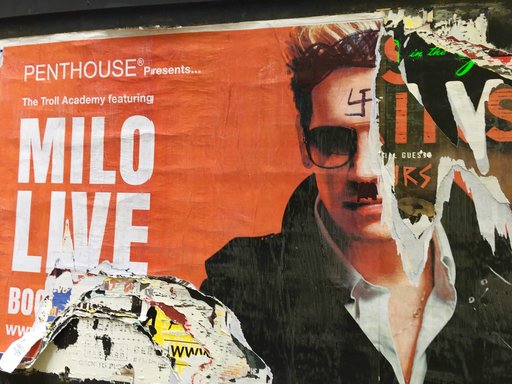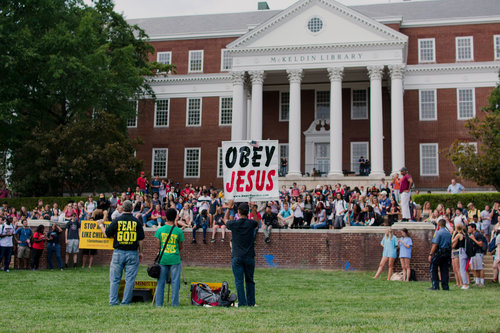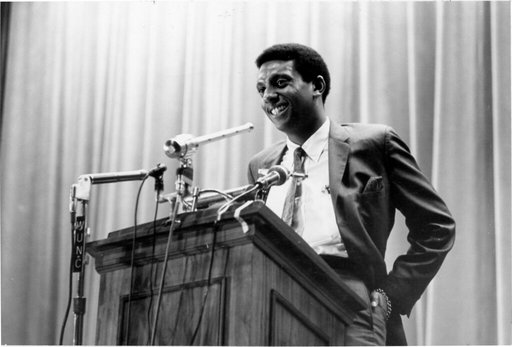Controversial Speeches and Rhetoric at UMD
Learning objectives
- To compare and contrast how students responded to divisive speech on campus during different periods
- To read primary source materials in order to analyze and relate issues of free speech and controversial rhetoric on campus
Discussion question
- How have student responses to controversial rhetoric changed over time? How has it stayed the same?
- How do First Amendment and free speech concepts define dialogue and rhetoric in these events?
- What elements of "democratic discourse" do we see in these events? What examples of "demogagic discourse" do we see in these events?
Links to relevant resources
To explore more resources, search UMD Student Newspapers
- The Diamondback, "'People are not okay with this': students protest Terps for Trump's Milo Yiannopoulos talk," October 4, 2016
- The Diamondback, "Armed with drums, pride flags and signs, hundreds drown out sexist demonstrators at UMD," September 17, 2019
- The Diamondback, "Police eject at least 10 protestors amid scuffles at speech by Ture," November 7, 1986 (pages 1 & 3)
- The Diamondback, "Students protest homophobic editorial," October 12, 1998 (page 1)
UMD Student Protest of Milo Yiannopoulos, 2016
“People are not okay with this”: students protest Terps for Trump’s Milo Yiannopoulos talk, by Naomi Grant, October 04, 2016
Background Information
- Milo Yiannopoulos is a far-right political commentator from Britain.
- Yiannopoulos is a former writer at Breitbart News, a far-right American news network, and has written several books on a range of social, political and religious subjects.
- Yiannopoulos's work and rhetoric has generated much controversy, and he has been accused of promoting violence against journalists and inciting harassment against women, Muslims and members of the LGBTQ+ communities.
- In Fall 2016, the student group Terps for Trump invited Yiannopoulos to speak on campus. His scheduled appearance was eventually cancelled.
Analysis & Discussion Questions
- According to the individuals highlighted in this article, why did they and other students and staff sign a petition? What motivated them to do so?
- How do interviewees relate the First Amendment to these series of events and issues?
- How do students' responses to this scheduled appearance compare to the student responses to the Key of David (Source #2) and Kwame Ture (Source #3) appearances?
- Based on Patricia Roberts-Miller's definitions, does this event demonstrate democratic discourse? Does it demonstrate demogagic discourse?


Key of David Demonstrations, 2019
Armed with drums, pride flags and signs, hundreds drown out sexist demonstrators at UMD, by Diamondback Staff, September 17, 2019.
Background Information
- The Key of David Christian Center is a self-described non-denominational church from Philadelphia.
- Members of Key of David have gained notoriety for demonstrating on college campuses in the Northeast and using derogatory chants and signage.
- Key of David demonstrators commonly use anti-LGBTQ, anti-feminist and anti-Muslim rhetoric in their demonstrations, and targets many other groups as well.
- Besides University of Maryland, Key of David has held demonstrations at other universities in the Northeast, including University of Pennsylvania and Towson University. Some of these events have led to physical confrontations between Key of David demonstrators and counter-protestors.

Analysis & Discussion Questions
- What were students protesting in this event?
- How did the volume of demonstrators and counter-protestors impact this event?
- How did the tactics used by counter-protestors in this event compare with tactics used during the Kwame Ture (Source #3) protest?
- One student described the demonstrators as "irrelevant." What do you think she meant by "irrelevant?" How could the concept of relevancy shape protest and discourse?
- Patricia Roberts-Miller says that demagoguery reshapes complicated social and political situations into "us (good) and them (some of whom are deliberately evil and the rest of whom are dupes)." Do you think the Key of David demonstration and counter-protest reflect Roberts-Miller's thinking?
Student Protests of Kwame Ture Speech, 1986
Police eject at least 10 protesters amid scuffles at speech by Ture, by Neff Hudson and Tina Lang, November 7, 1986
Background Information
- Stokely Carmichael was an influential leader of the civil rights and Pan-African movements of the mid-late 20th century. He changes his name to Kwame Ture in 1969.
- While he first emerged as a leader of the Student Nonviolent Coordinating Committee (SNCC), Ture was perhaps best known as a prominent leader of the Black Power movement during the mid-late 1960s.
- Ture was considered a controversial figure among many groups, including Jewish communities. Ture was outspokenly anti-Zionist, and famously proclaimed that "the only good Zionist is a dead Zionist."
- In 1986, Ture was invited to speak at University of Maryland.

Analysis and Discussion Questions
- According to the article, why did students hold a counter-protest during Ture's speech, as opposed to before or after it?
- According to the protestor's views highlighted in the article, how is the First Amendment connected to this event?
- What role did typically "neutral" parties--including police officers--play in this event? How do their roles and actions compare to similar events from other periods?
- Do you think the actions taken by student protestors helped or hurt their intentions? Why?
Students Protest Homophobic Diamondback column, 1998
Students protest homophobic editorial, by Josh Korr, October 12, 1998
Background Information
- Between 25-30 UMD students protested outside the Student Union in October 1998 to protest an editorial published in The Diamondback that they believed was homophobic.
- The guest column--published three days before the protest and written by senior Carter Clark--called out gay people as "repulsive" and "genetically defective" and accused the LGBT community of "pushing their 'twisted and perverted' views on everyone in America."
Analysis & Discussion Questions
- What do you think was the goal of the protestors who passed out copies of the homophobic newspaper column to passers-by?
- What is the newspaper policy, as explained by Kross? How did The Diamondback's policy on free speech resemble or differ from other institutional practices demonstrated in the other articles?
- Do you agree with the policy outlined by Kross? Do you think this policy enables or inhibits democratic dialogue?
